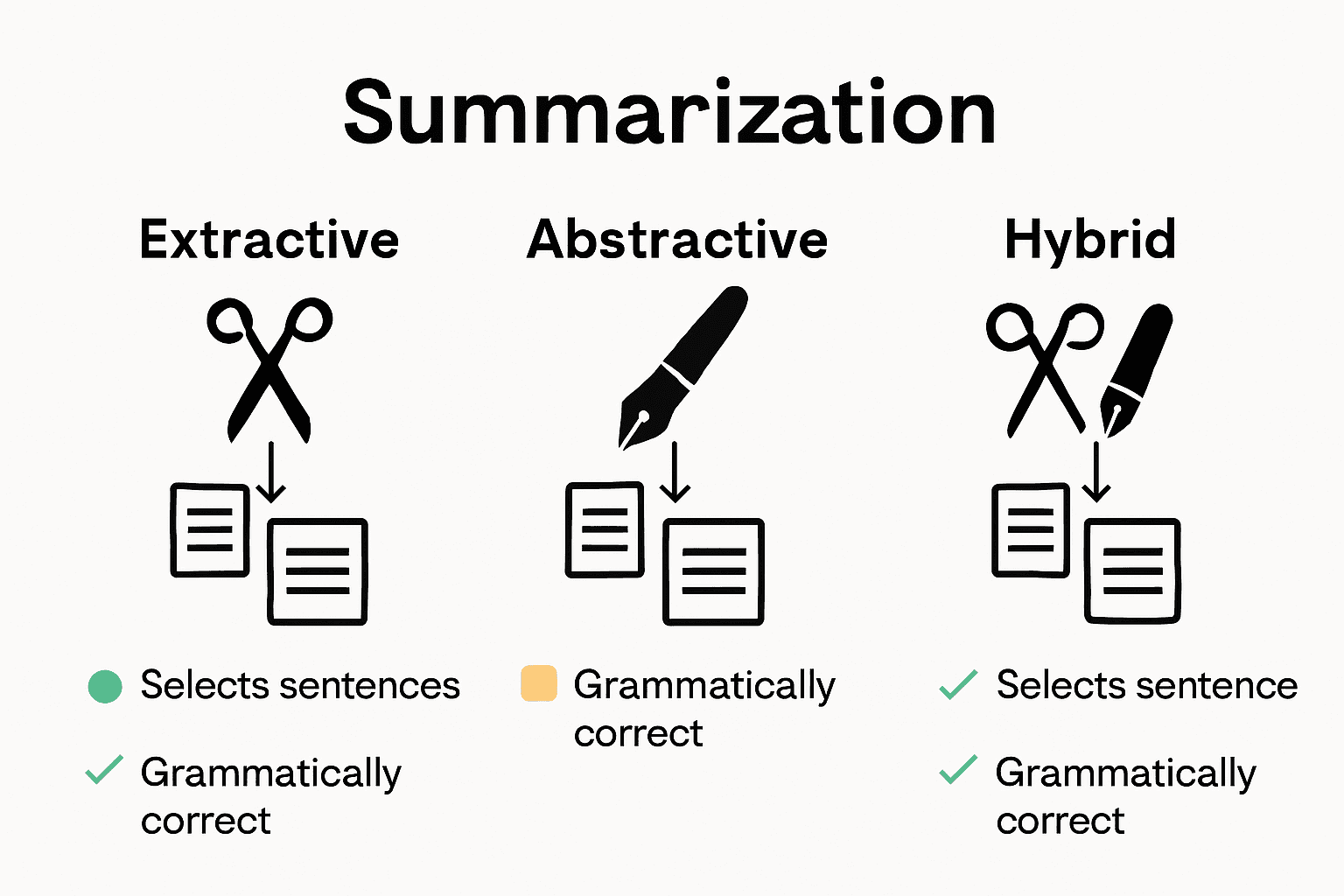Content Summarizers Explained: Time-Saving AI Tools

Over 80 percent of professionals say they feel overwhelmed by the sheer volume of information they must process every day. Sorting through endless reports, research papers, or training videos can easily drain both time and energy. Content summarizers step in as a practical answer by transforming complex material into clear, bite-sized insights. Whether you are a student, a business leader, or a lifelong learner, understanding how these AI tools work helps you harness information faster and more effectively.
Table of Contents
- Defining Content Summarizers And Core Concepts
- Types Of Content Summarizers And Key Differences
- How AI-Powered Summarizers Extract Video Insights
- Real-World Applications In Learning And Work
- Risks, Limitations, And Best Practices To Consider
Key Takeaways
| Point | Details |
|---|---|
| Definition of Content Summarizers | AI tools that condense lengthy texts into concise, actionable insights using extractive or abstractive methods. |
| Methodological Approaches | Extractive summarizes original sentences, while abstractive generates new sentences, each suitable for different types of content. |
| Applications Across Fields | Content summarizers facilitate efficient information processing in academic and professional settings, enhancing decision-making and learning. |
| Risks and Best Practices | Users should cross-reference AI summaries with original content and maintain oversight to mitigate risks like misinterpretation and loss of nuanced details. |
Defining Content Summarizers and Core Concepts
Content summarizers are AI-powered tools designed to extract and condense key information from lengthy texts, videos, or documents into concise, digestible formats. According to research from iieta.org, these advanced technologies employ sophisticated techniques to transform complex information into clear, streamlined summaries.
At their core, content summarizers utilize two primary methodological approaches: extractive and abstractive summarization. The extractive method identifies and preserves the most important original sentences from the source material, essentially “cutting and pasting” the most relevant content. Conversely, the abstractive approach goes beyond simple extraction by generating entirely new sentences that capture the core meaning, similar to how a human might paraphrase complex information.
Research from ajer.org highlights the nuanced challenges in content summarization, emphasizing that these tools must balance several critical factors:
- Preserving original context and meaning
- Maintaining semantic coherence
- Reducing information to its most essential components
- Ensuring readability and comprehension
For professionals and learners who regularly consume large volumes of information, content summarizers represent a powerful solution to information overload. By transforming lengthy content into quick, actionable insights, these AI-driven tools enable more efficient learning and research. Check out our guide on the benefits of content summarizers to explore how these technologies can revolutionize your information consumption strategy.
Types of Content Summarizers and Key Differences
Content summarizers are not a one-size-fits-all solution. According to research from iieta.org, these tools can be broadly categorized into distinct types with unique methodological approaches. Understanding these variations helps users select the most appropriate summarization technique for their specific needs.
The primary categories of content summarizers include extractive, abstractive, and hybrid methods. Extractive summarizers work by identifying and extracting the most significant sentences directly from the original text, essentially creating a summary by “cutting and pasting” key information. In contrast, abstractive summarizers generate entirely new sentences that capture the core meaning, effectively paraphrasing the original content in a more dynamic and intelligent manner.
Research from ijert.org provides deeper insights into the key differences between these approaches:
- Extractive Summarization
- Preserves original text fragments
- Lower computational complexity
- More predictable output
- Best for technical or factual content
- Abstractive Summarization
- Generates novel sentences
- Higher computational complexity
- More creative and contextual output
- Ideal for narrative or complex content
For professionals seeking to understand the nuanced world of content summarization, our guide on content summary types offers a comprehensive exploration of these methodological approaches. By recognizing the strengths and limitations of each summarization technique, users can more effectively leverage these powerful AI tools to transform how they consume and process information.

Here’s a comparison of the main types of content summarization methods:

| Method | Description | Key Strengths | Ideal Use Cases |
|---|---|---|---|
| Extractive | Selects and assembles key original sentences | Fast Accurate Predictable |
Technical reports News feeds |
| Abstractive | Generates new sentences capturing core meaning | Creative Context-aware Flexible |
Narratives Complex documents |
| Hybrid | Combines extractive and abstractive approaches | Balanced output Flexible |
Broad learning Business reviews |
How AI-Powered Summarizers Extract Video Insights
AI-powered video summarization represents a sophisticated technological breakthrough in content processing. According to research from ijcrt.org, these advanced systems leverage complex natural language processing and machine learning algorithms to transform lengthy video content into concise, meaningful insights.
The extraction process involves multiple intricate stages. AI summarizers first analyze the video’s audio track, utilizing speech recognition technologies to transcribe spoken content. Simultaneously, they perform visual analysis, identifying key visual elements, scene transitions, and contextual cues that signal important moments. By combining these linguistic and visual data points, the AI can intelligently determine which segments represent the most significant information.
Research from ijettjournal.org highlights the core methodological approaches in video insight extraction:
- Speech-to-Text Conversion
- Transcribes spoken dialogue
- Identifies key terminology
- Captures semantic context
- Enables content classification
- Visual Feature Analysis
- Detects scene changes
- Recognizes speaker emotions
- Maps visual engagement
- Tracks presentation dynamics
For professionals and learners seeking to understand the intricacies of AI-driven video summarization, our guide on understanding the role of AI in video review offers deeper insights into these revolutionary technologies. By breaking down complex multimedia content into digestible summaries, AI-powered tools are transforming how we consume and understand information across various domains.
Real-World Applications in Learning and Work
Content summarizers have transformed how professionals and students process information across diverse domains. According to research from ijsrp.org, these AI-powered tools dramatically enhance information processing and decision-making by distilling extensive documents into concise, actionable insights.
In academic settings, content summarizers serve as powerful learning accelerators. Students can rapidly comprehend complex research papers, lecture materials, and textbook chapters without getting overwhelmed by excessive details. Professionals similarly benefit by quickly extracting critical information from reports, market analyses, research studies, and industry whitepapers, enabling faster strategic decision-making and more efficient knowledge acquisition.
Research from writing.colostate.edu highlights the multifaceted applications of summarization techniques:
- Academic Applications
- Condensing research papers
- Preparing study notes
- Understanding complex textbooks
- Supporting literature reviews
- Professional Applications
- Analyzing market reports
- Reviewing technical documentation
- Preparing executive summaries
- Monitoring industry trends
Professionals looking to stay ahead of the learning curve can leverage these advanced tools. Our guide on education tools for 2025 provides additional insights into how technology is revolutionizing knowledge acquisition and information processing across various sectors.
Risks, Limitations, and Best Practices to Consider
While content summarizers offer remarkable capabilities, they are not infallible technological solutions. According to research from cs.cmu.edu, these AI-driven tools come with inherent challenges that users must understand and navigate carefully to maximize their effectiveness.
The primary risks associated with automated summarization include potential contextual misinterpretation and information reduction. AI systems might accidentally remove critical nuanced details or misunderstand complex semantic contexts, potentially leading to summaries that are technically accurate but fundamentally misleading. This becomes particularly problematic in specialized domains like legal, medical, or technical fields where precision is paramount.
Research highlights several critical best practices for mitigating these risks:
- Verification Strategies
- Always cross-reference AI summaries with original content
- Use multiple summarization tools for comparison
- Develop a critical reading approach
- Maintain human oversight
- Technical Limitations to Monitor
- Recognize potential bias in training data
- Understand the AI’s knowledge cutoff
- Assess summarization accuracy periodically
- Be aware of domain-specific constraints
Professionals seeking to implement these tools effectively should approach content summarizers as collaborative intelligence rather than absolute authorities. By maintaining a balanced perspective and understanding both the capabilities and limitations of AI-powered summarization, users can transform these tools into powerful knowledge management assets.
Unlock Time-Saving Insights with AI-Powered Video Summaries
The article highlights the challenge of information overload and the need for clear, concise content summaries that preserve context and meaning. If you often feel overwhelmed by long videos and lectures, struggling to grasp key points quickly, SummYT is built to solve this exact problem. By combining extractive and abstractive summarization methods with AI-driven insights, SummYT transforms any YouTube video into easy-to-understand highlights so you can focus on what matters most.

Discover how SummYT can accelerate your learning and work efficiency today. Whether you are a student, professional, or lifelong learner, our platform offers unlimited summaries, multilingual support, and one-click browser extensions to save you hours. Take control of your time and knowledge now by visiting SummYT and explore our guides on the benefits of content summarizers and understanding the role of AI in video review to see how AI reshapes your information consumption.
Frequently Asked Questions
What are content summarizers?
Content summarizers are AI-powered tools that extract and condense key information from lengthy texts or videos into concise formats, helping users digest complex information quickly.
What is the difference between extractive and abstractive summarization?
Extractive summarization involves selecting and preserving key sentences from the original text, while abstractive summarization generates new sentences that paraphrase the original content, capturing its core meaning.
How do AI-powered summarizers extract insights from videos?
AI-powered video summarizers use natural language processing and machine learning to analyze audio and visual elements of videos, transcribing speech and identifying key scenes to create meaningful summaries.
What are the risks and limitations of using content summarizers?
Content summarizers may misinterpret context or reduce important details, risking the accuracy of the summaries. It’s essential to verify AI-generated summaries with original content for precision.




